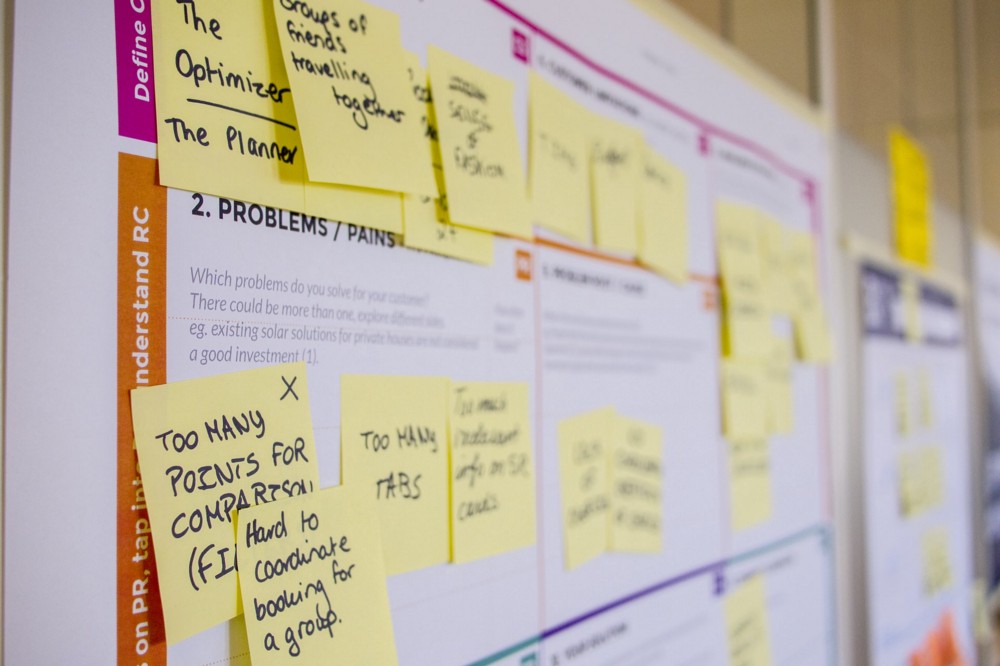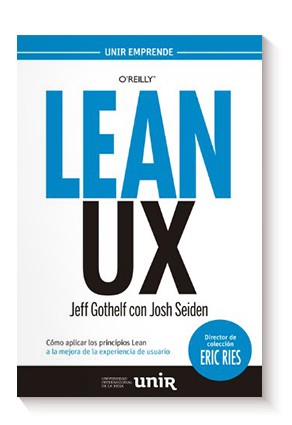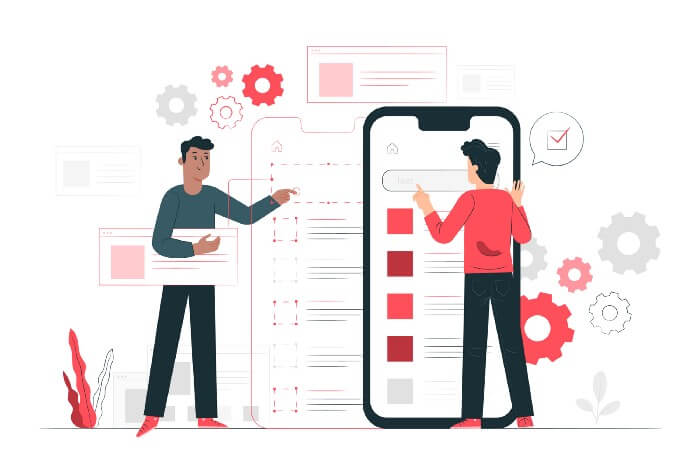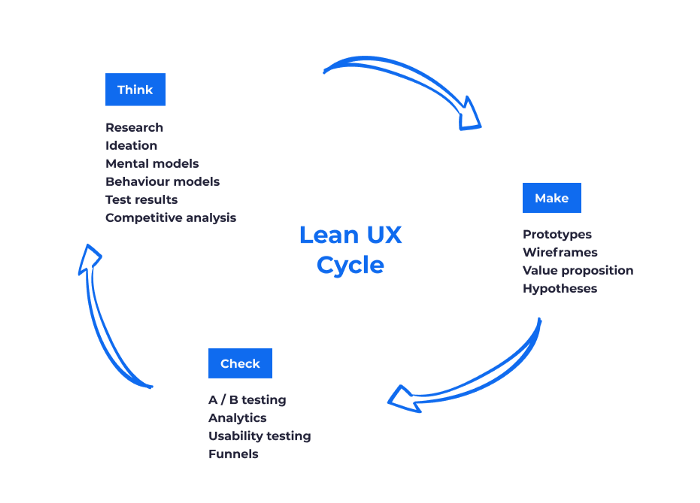Lean UX for better solutions
The Lean UX approach focuses on improving relationships and collaborations in teams, eliminating unnecessary processes, maximizing work efficiency and learning from mistakes to ultimately achieve better solutions.

What is Lean UX?
Years ago, everything UX related (although the term UX was unknown) was included in software development. Software developers were responsible for obtaining customer requirements and developing assumptions based on their requirements to implement those assumptions. Lean UX does not start with requirements, but with assumptions. Based on these assumptions, hypotheses are created and validated; based on the validation of hypotheses, it is measured whether the results have been achieved or not.

Jeff Gothelf, the author of the Lean UX book, who witnessed how the software development industry changed radically, created a new perspective of work applying the principles of Lean Startup in design from a user experience perspective, converging with methodologies “ Design Thinking” and “agile” software development. Nowadays, companies need and look for quality digital products that are developed in the shortest time possible, focusing on users and applying available technology or knowledge. Lean UX methodology is a solution to this challenge and the evolution in the design of digital products.
Why Lean UX?
Lean UX takes a different approach. Small changes are made upfront and tested with users right away, using low-fidelity prototypes until an optimal solution is obtained. It focuses less on traditional UX deliverables. The Lean methodology seeks to streamline the work process and achieve business objectives in less time.
To do this, it gets rid of the requirements and uses a problem statement to generate assumptions that can be used to create hypotheses.
These assumptions are usually generated in a workshop as a team, where the problem is presented and ideas are brainstormed to solve the problem.
The most typical questions to ask ourselves would be:
- Who are our users?
- What is the product used for?
- When and how is the product used?
- In what situations is it used?
- What will be the most important functionality?
- What is the greatest risk when delivering the product?
The main foundations of Lean UX
Lean UX stands on these main important foundations as a guide in the process:
Design Thinking
A methodology that uses the designer’s thinking, and tools to adapt to the needs of people while maintaining a balance between what is technically possible and viable at a business level.
“Agile” development methodologies
Although this is a development-focused methodology, “agile” values are also at the heart of Lean UX.
- Ideas and solutions should be shared, tested and exchanged frequently.
- Collaborating with colleagues and clients creates an environment of common understanding of problems, needs and possible solutions. This results in fast interactions with less heavy documentation.
- Responds to changes quickly. It is assumed that the first hypotheses or solutions may be incorrect, but the objective is to discover what is wrong as soon as possible. Once a better solution is found, changes are made and the same process is repeated.
Lean Startup
This method was created by Eric Ries, who uses a “create-measure-learn” feedback loop to build an MVP (minimum viable product) and thus begin the learning and construction process as soon as possible, maximizing available resources and minimizing risk. The idea is to build the most basic version possible of the product, test it, and if there are no valuable results, abandon it; if there are valuable results, improve it.
- MVP is created
- MVP is presented to the client
- Changes are applied
- A new iteration after the changes is done
Lean UX vs Agile UX
Sometimes is difficult to distinguish between the two concepts. It is a difficult area with many nuances and subtle differences. The most important thing is to understand their origins, principles, and applicability in product development. One thing is clear, they are design methods that complement each other, and they are mixed in real product design and development.
We could say that Agile UX pays more attention to effective communication and cooperation in projects, while Lean UX makes “user experience” its core; it focuses on the users and meeting their needs in product development, to design the best possible user experience.
In Agile UX the project is divided into multiple parts, known as sprints; each part is planned, designed, build, tested and reviewed. By the end of the sprint, there is a sprint review to analyse the changes that need to be done to improve the product and the next sprint is planned accordingly. Each iteration is developed through close communication and collaboration. Like Lean UX, Agile provides the same “review, change and repeat” process, with new sprints built from the results of previous versions until a final version is achieved.
Lean UX focuses on working with problem statements and assumptions instead of requirements. Having conversations about those assumptions during the early stages helps to keep the team focused on the big picture throughout the process. When there is less certainty in a project, Lean UX offers the opportunity to quickly test hypotheses with real users and develop interim products that meet user needs and preferences. It may take longer to get to the final product, but by the time it will have been thoroughly tested.
So, what is the Lean UX Cycle?
We can summarise this cycle or process in think, make and check.
“Thinking” stage
A problem is effectively addressed to obtain a hypothesis. Most likely, a brainstorming session will be held, in which the problem is presented to generate ideas and assumptions. These assumptions are believed to be true and they help designers to understand an idea that may result in a hypothesis.
Creation stage “make”
Solutions are created in this stage; it goes from having more abstract thoughts to more specific solutions. In Lean UX, a lot of attention is paid to both low and high-fidelity prototypes. Since Lean UX involves testing multiple hypotheses in a quick period of time, the use of rapid prototyping tools allows minimal effort.
Verification stage “check”
Includes validating solutions using various methods. These tests are based on the same principles used in traditional UX methodologies, but the approach tends to be faster. It involves testing with real people, preferably with real users of the product to measure the validity of the hypothesis raised.

Summarising
These are just concepts described at a high level that can allow us to start when implementing Lean UX in an agile environment. Lean UX is focused on continuous learning, being an evolution of the design process towards a digitally, highly changing, dominant future. By combining the ideas of Lean Startup, agile development and Design Thinking, the uncertainty in product design is eliminated, reaching an objective. In summary, Lean UX is:
- Efficient
- Collaborative
- Fast
- User-centric
Did you like our post? Find out all our posts about UX and UI!
Configuration ACCEPT Reject all
Privacy Overview
More information in the Cookies Policy.
| Cookie | Duration | Description |
|---|---|---|
| __cfduid | 1 year | The cookie is used by cdn services like CloudFare to identify individual clients behind a shared IP address and apply security settings on a per-client basis. It does not correspond to any user ID in the web application and does not store any personally identifiable information. |
| __cfduid | 29 days 23 hours 59 minutes | The cookie is used by cdn services like CloudFare to identify individual clients behind a shared IP address and apply security settings on a per-client basis. It does not correspond to any user ID in the web application and does not store any personally identifiable information. |
| __cfduid | 1 year | The cookie is used by cdn services like CloudFare to identify individual clients behind a shared IP address and apply security settings on a per-client basis. It does not correspond to any user ID in the web application and does not store any personally identifiable information. |
| __cfduid | 29 days 23 hours 59 minutes | The cookie is used by cdn services like CloudFare to identify individual clients behind a shared IP address and apply security settings on a per-client basis. It does not correspond to any user ID in the web application and does not store any personally identifiable information. |
| _ga | 1 year | This cookie is installed by Google Analytics. The cookie is used to calculate visitor, session, campaign data and keep track of site usage for the site's analytics report. The cookies store information anonymously and assign a randomly generated number to identify unique visitors. |
| _ga | 1 year | This cookie is installed by Google Analytics. The cookie is used to calculate visitor, session, campaign data and keep track of site usage for the site's analytics report. The cookies store information anonymously and assign a randomly generated number to identify unique visitors. |
| _ga | 1 year | This cookie is installed by Google Analytics. The cookie is used to calculate visitor, session, campaign data and keep track of site usage for the site's analytics report. The cookies store information anonymously and assign a randomly generated number to identify unique visitors. |
| _ga | 1 year | This cookie is installed by Google Analytics. The cookie is used to calculate visitor, session, campaign data and keep track of site usage for the site's analytics report. The cookies store information anonymously and assign a randomly generated number to identify unique visitors. |
| _gat_UA-326213-2 | 1 year | No description |
| _gat_UA-326213-2 | 1 year | No description |
| _gat_UA-326213-2 | 1 year | No description |
| _gat_UA-326213-2 | 1 year | No description |
| _gid | 1 year | This cookie is installed by Google Analytics. The cookie is used to store information of how visitors use a website and helps in creating an analytics report of how the wbsite is doing. The data collected including the number visitors, the source where they have come from, and the pages viisted in an anonymous form. |
| _gid | 1 year | This cookie is installed by Google Analytics. The cookie is used to store information of how visitors use a website and helps in creating an analytics report of how the wbsite is doing. The data collected including the number visitors, the source where they have come from, and the pages viisted in an anonymous form. |
| _gid | 1 year | This cookie is installed by Google Analytics. The cookie is used to store information of how visitors use a website and helps in creating an analytics report of how the wbsite is doing. The data collected including the number visitors, the source where they have come from, and the pages viisted in an anonymous form. |
| _gid | 1 year | This cookie is installed by Google Analytics. The cookie is used to store information of how visitors use a website and helps in creating an analytics report of how the wbsite is doing. The data collected including the number visitors, the source where they have come from, and the pages viisted in an anonymous form. |
| attributionCookie | session | No description |
| cookielawinfo-checkbox-analytics | 1 year | Set by the GDPR Cookie Consent plugin, this cookie is used to record the user consent for the cookies in the "Analytics" category . |
| cookielawinfo-checkbox-necessary | 1 year | This cookie is set by GDPR Cookie Consent plugin. The cookies is used to store the user consent for the cookies in the category "Necessary". |
| cookielawinfo-checkbox-necessary | 11 months | This cookie is set by GDPR Cookie Consent plugin. The cookies is used to store the user consent for the cookies in the category "Necessary". |
| cookielawinfo-checkbox-necessary | 11 months | This cookie is set by GDPR Cookie Consent plugin. The cookies is used to store the user consent for the cookies in the category "Necessary". |
| cookielawinfo-checkbox-necessary | 1 year | This cookie is set by GDPR Cookie Consent plugin. The cookies is used to store the user consent for the cookies in the category "Necessary". |
| cookielawinfo-checkbox-non-necessary | 11 months | This cookie is set by GDPR Cookie Consent plugin. The cookies is used to store the user consent for the cookies in the category "Non Necessary". |
| cookielawinfo-checkbox-non-necessary | 11 months | This cookie is set by GDPR Cookie Consent plugin. The cookies is used to store the user consent for the cookies in the category "Non Necessary". |
| cookielawinfo-checkbox-non-necessary | 11 months | This cookie is set by GDPR Cookie Consent plugin. The cookies is used to store the user consent for the cookies in the category "Non Necessary". |
| cookielawinfo-checkbox-non-necessary | 1 year | This cookie is set by GDPR Cookie Consent plugin. The cookies is used to store the user consent for the cookies in the category "Non Necessary". |
| cookielawinfo-checkbox-performance | 1 year | Set by the GDPR Cookie Consent plugin, this cookie is used to store the user consent for cookies in the category "Performance". |
| cppro-ft | 1 year | No description |
| cppro-ft | 7 years 1 months 12 days 23 hours 59 minutes | No description |
| cppro-ft | 7 years 1 months 12 days 23 hours 59 minutes | No description |
| cppro-ft | 1 year | No description |
| cppro-ft-style | 1 year | No description |
| cppro-ft-style | 1 year | No description |
| cppro-ft-style | session | No description |
| cppro-ft-style | session | No description |
| cppro-ft-style-temp | 23 hours 59 minutes | No description |
| cppro-ft-style-temp | 23 hours 59 minutes | No description |
| cppro-ft-style-temp | 23 hours 59 minutes | No description |
| cppro-ft-style-temp | 1 year | No description |
| i18n | 10 years | No description available. |
| IE-jwt | 62 years 6 months 9 days 9 hours | No description |
| IE-LANG_CODE | 62 years 6 months 9 days 9 hours | No description |
| IE-set_country | 62 years 6 months 9 days 9 hours | No description |
| JSESSIONID | session | The JSESSIONID cookie is used by New Relic to store a session identifier so that New Relic can monitor session counts for an application. |
| viewed_cookie_policy | 11 months | The cookie is set by the GDPR Cookie Consent plugin and is used to store whether or not user has consented to the use of cookies. It does not store any personal data. |
| viewed_cookie_policy | 1 year | The cookie is set by the GDPR Cookie Consent plugin and is used to store whether or not user has consented to the use of cookies. It does not store any personal data. |
| viewed_cookie_policy | 1 year | The cookie is set by the GDPR Cookie Consent plugin and is used to store whether or not user has consented to the use of cookies. It does not store any personal data. |
| viewed_cookie_policy | 11 months | The cookie is set by the GDPR Cookie Consent plugin and is used to store whether or not user has consented to the use of cookies. It does not store any personal data. |
| VISITOR_INFO1_LIVE | 5 months 27 days | A cookie set by YouTube to measure bandwidth that determines whether the user gets the new or old player interface. |
| wmc | 9 years 11 months 30 days 11 hours 59 minutes | No description |
| Cookie | Duration | Description |
|---|---|---|
| __cf_bm | 30 minutes | This cookie, set by Cloudflare, is used to support Cloudflare Bot Management. |
| sp_landing | 1 day | The sp_landing is set by Spotify to implement audio content from Spotify on the website and also registers information on user interaction related to the audio content. |
| sp_t | 1 year | The sp_t cookie is set by Spotify to implement audio content from Spotify on the website and also registers information on user interaction related to the audio content. |
| Cookie | Duration | Description |
|---|---|---|
| _hjAbsoluteSessionInProgress | 1 year | No description |
| _hjAbsoluteSessionInProgress | 1 year | No description |
| _hjAbsoluteSessionInProgress | 1 year | No description |
| _hjAbsoluteSessionInProgress | 1 year | No description |
| _hjFirstSeen | 29 minutes | No description |
| _hjFirstSeen | 29 minutes | No description |
| _hjFirstSeen | 29 minutes | No description |
| _hjFirstSeen | 1 year | No description |
| _hjid | 11 months 29 days 23 hours 59 minutes | This cookie is set by Hotjar. This cookie is set when the customer first lands on a page with the Hotjar script. It is used to persist the random user ID, unique to that site on the browser. This ensures that behavior in subsequent visits to the same site will be attributed to the same user ID. |
| _hjid | 11 months 29 days 23 hours 59 minutes | This cookie is set by Hotjar. This cookie is set when the customer first lands on a page with the Hotjar script. It is used to persist the random user ID, unique to that site on the browser. This ensures that behavior in subsequent visits to the same site will be attributed to the same user ID. |
| _hjid | 1 year | This cookie is set by Hotjar. This cookie is set when the customer first lands on a page with the Hotjar script. It is used to persist the random user ID, unique to that site on the browser. This ensures that behavior in subsequent visits to the same site will be attributed to the same user ID. |
| _hjid | 1 year | This cookie is set by Hotjar. This cookie is set when the customer first lands on a page with the Hotjar script. It is used to persist the random user ID, unique to that site on the browser. This ensures that behavior in subsequent visits to the same site will be attributed to the same user ID. |
| _hjIncludedInPageviewSample | 1 year | No description |
| _hjIncludedInPageviewSample | 1 year | No description |
| _hjIncludedInPageviewSample | 1 year | No description |
| _hjIncludedInPageviewSample | 1 year | No description |
| _hjSession_1776154 | session | No description |
| _hjSessionUser_1776154 | session | No description |
| _hjTLDTest | 1 year | No description |
| _hjTLDTest | 1 year | No description |
| _hjTLDTest | session | No description |
| _hjTLDTest | session | No description |
| _lfa_test_cookie_stored | past | No description |
| Cookie | Duration | Description |
|---|---|---|
| loglevel | never | No description available. |
| prism_90878714 | 1 month | No description |
| redirectFacebook | 2 minutes | No description |
| YSC | session | YSC cookie is set by Youtube and is used to track the views of embedded videos on Youtube pages. |
| yt-remote-connected-devices | never | YouTube sets this cookie to store the video preferences of the user using embedded YouTube video. |
| yt-remote-device-id | never | YouTube sets this cookie to store the video preferences of the user using embedded YouTube video. |
| yt.innertube::nextId | never | This cookie, set by YouTube, registers a unique ID to store data on what videos from YouTube the user has seen. |
| yt.innertube::requests | never | This cookie, set by YouTube, registers a unique ID to store data on what videos from YouTube the user has seen. |


